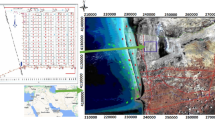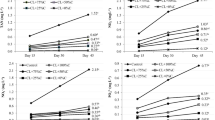Abstract
A model experiment in which water was circulated between shrimp aquaculture ponds (Ponds 1, 2, and 5), and mangrove enclosures (Ponds 3 and 4), was carried out at the Samut Songkhram Coastal Aquatic Research Station, Thailand, from March through July 2003. Five ponds with a size of 40m×20m and 1.5m deep were used for this experiment. Ten thousand shrimp larvae Penaeus monodon at the PL-15 stage were stocked in Ponds 1 and 5, and 20 000 larvae were stocked in Pond 2. Mangrove Rhizophora mucronata (476 trees) had been planted in each of Ponds 3 and 4 in July 2002. Approximately 30% of the water in Ponds 2 and 5 was moved to the mangrove enclosures by siphon (Ponds 3 and 4, respectively) every Thursday, and the same amount was returned to the shrimp ponds by pump every Monday over the 136-day experiment. Shrimp incorporated 30.3, 25.6, and 33.7% of the input nitrogen as feed in Ponds 1, 2, and 5. Since 2.02 kg N in Pond 2 and 0.76 kg N in Pond 5 was transported to the mangrove ecosystem, and 4.26 kg N in Pond 2 and 3.98 kg N in Pond 5 was retained in water and mud, it was estimated that between 2.1 and 5.2 unit areas of mangroves is required to remove the nitrogen remaining in the aquaculture pond.
Similar content being viewed by others
References
Briggs MRP, Funge-Smith SJ. A nutrient budget of some intensive marine shrimp ponds in Thailand. Aquacul. Fish. Manage. 1994; 25: 789–811.
FAO. Aquaculture Production, Fishery Statistics. In: FAO Yearbook 2002, 94/2. Food and Agriculture Organization, Rome. 2004.
FAO. Commodities, Fishery Statistics. In: FAO Yearbook 2002, 95. Food and Agriculture Organization, Rome. 2004.
Clough BF. Status and value of mangrove forests. In: Clough BF (ed.). The Economic and Environmental Values of Mangrove Forests and Their Present Stage of Conservation in the South-East Asia/Pacific Region. ISME/ITTO/JIAM, International Society for Mangrove Ecosystems, International Timber Organization, and Japan International Association for Mangroves, Okinawa. 1993; 1–10.
Mastaller M. Mangroves. Tropical Press, Kuala Lumpur, Malaysia. 1997.
Briggs MRP. Status, problems and solutions for a sustainable shrimp culture industry. In: Briggs MRP (ed.). Development of Strategies for Sustainable Shrimp Farming. Final report to the Overseas Development Administration. Research Project R4751. Institute of Aquaculture, University of Stirling, Stirling, UK. 1994.
Stevenson NJ. Disused shrimp ponds: options for redevelopment of mangrove. Coastal Manag. 1997; 25: 423–425.
Burford MA, Costanzo SD, Dennison WC, Jackson CJ, Jones AB, McKinnon AD, Preston MP, Trott LA. A synthesis of dominant ecological processes in intensive shrimp ponds and adjacent coastal environments in NE Australia. Mar. Pollut. Bull. 2003; 46: 1456–1469.
McKinnon AD, Trott LA, Alongi DM, Davidson A. Water column production and nutrient characteristics in mangrove creeks receiving shrimp farm effluent. Aquacul. Res. 2002; 33: 55–73.
Trott LA, Alongi DM. Impact of shrimp pond effluent on water quality and phytoplankton biomass in tropical mangrove estuary. Mar. Pollut. Bull. 2000; 40: 947–951.
Primavera JH. Integrated mangrove-aquaculture systems in Asia. In: Integrated Coastal Zone Management, Autumn Edition. ICG, London. 2000; 121–130.
Alongi DM, Johnston DJ, Xuan TT. Carbon and nitrogen budgets in shrimp ponds of extensive mixed shrimpmangrove forestry farms in the Mekong delta. Vietnam. Aquacul. Res. 2000; 31: 387–399.
Riviera-Monroy VH, Torres LA, Bahamon N. The potential use of mangrove forests as nitrogen sinks of shrimp aquaculture pond effluents: the role of denitrification. J. World Aquacul. Soc. 1999; 30: 12–25.
Robertson AI, Phillips MJ. Mangroves as filters of shrimp pond effluent: prediction and biogeochemical research needs. Hydrobiologia 1995; 295: 311–321.
Shimoda T, Fujioka Y, Srithong C, Aryuthaka C. Phosphorus budget in shrimp aquaculture pond with mangrove enclosure and aquaculture performance. Fish. Sci. 2005; 71: 1249–1255.
Suzuki R, Ishimaru T. An improved method for the determination of phytoplankton chlorophyll using N,N-dimethylformamide. J. Oceanogr. Soc. Jpn 1990; 46: 190–194.
Sasaki K, Sawada Y. Determination of ammonia in estuary. Nippon Suisan Gakkaishi 1980; 46: 319–321.
Parsons TR, Maita Y, Lalli CM. A Manual of Chemical and Biological Methods for Seawater Analysis. Pergamon, Oxford. 1984.
Solorzano L, Sharp JH. Determination of total dissolved nitrogen in natural waters. Limnol. Oceanogr. 1980; 25: 751–754.
Shimoda T, Srithong C, Aryuthaka C. Attempt at purification of effluent and sediment in shrimp aquaculture ponds using mangrove trees. JARQ 2005; 39: 139–145.
Hunt R. Plant Growth Curves: The Functional Approach to Plant Growth Analysis. Edward Arnold, London. 1982.
Thampanya U, Vermaat JE, Duarte CM. Colonization success of common Thai mangrove species as function of shelter from water movement. Mar. Ecol. Prog. Ser. 2002; 237: 111–120.
Author information
Authors and Affiliations
Corresponding author
Rights and permissions
About this article
Cite this article
Shimoda, T., Fujioka, Y., Srithong, C. et al. Effect of water exchange with mangrove enclosures based on nitrogen budget in Penaeus monodon aquaculture ponds. Fish Sci 73, 221–226 (2007). https://doi.org/10.1111/j.1444-2906.2007.01327.x
Received:
Accepted:
Issue Date:
DOI: https://doi.org/10.1111/j.1444-2906.2007.01327.x




